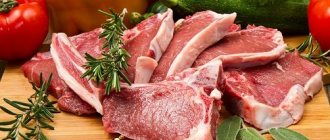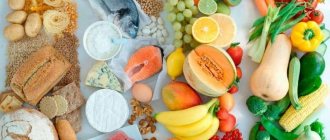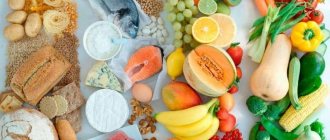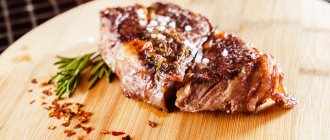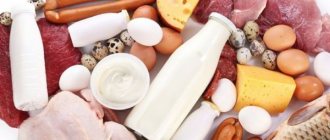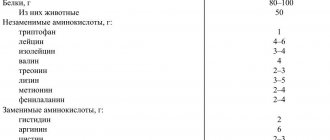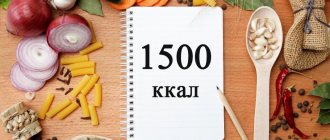A diet of 1300 calories per day helps you safely lose weight without harming your health. Dietary nutrition is developed taking into account human needs for vitamins and microelements, the balance of proteins, fats and carbohydrates. Restrictions in dietary nutrition do not particularly affect a person’s activity and mood, since low-calorie food can also be tasty, but most importantly, healthy.
The essence and goals of the 1300 calorie per day diet
The human body needs energy to function, which comes from food.
On average, the body requires from 1500 to 2500 kcal per day (this depends on the person’s gender, weight, height, age, level of physical activity and other factors). The goal of the diet is to create a calorie deficit, in which the body will be forced to burn glycogen stores and then fat deposits for energy. At the same time, it is important not only to limit calories, but also to provide the body with proteins and other nutrients so that during weight loss, fat cells are destroyed, and not muscle fibers.
How to change your calorie intake depending on your goals?
If a person wants to lose weight, he will need to reduce the calorie content of his diet in relation to the BAC. For effective weight correction without negative consequences for health and slowing down metabolism, the daily caloric intake must be reduced by 15-20% of the norm (SCR). Believe me, this is quite enough.
Similarly: if a client needs to gain weight while underweight, then the daily caloric intake of his menu needs to be increased by 15-20% of the norm (SK). As you can see, everything is not so complicated.
Now let's move on to the distribution of proteins, fats and carbohydrates (BJU) within the daily caloric intake (students of the Lara Serebryanskaya School of Dietetics learn this first of all)...
Pros and effectiveness of the diet
This weight loss course is popular because... has a number of advantages:
- The diet is varied, products and dishes can be changed every day, so the menu does not get boring, and the likelihood of breakdowns is reduced.
- Diet products are affordable and can be obtained at any time of the year.
- The diet is as safe as possible, because... Together with food, the body receives nutrients, vitamins, and minerals.
- Small meals help reduce stomach volume. Even after leaving the diet, the feeling of hunger appears less often, and satiety during meals comes faster.
- The diet helps speed up metabolic processes, free the body of toxins and excess fluid.
The diet speeds up metabolic processes, the menu does not get boring.
Conclusion
So, you can’t eat more than 1200 kcal worth of food per day. If you do not follow this recommendation, you will not be able to lose weight. You should also not eat less than a given norm, since metabolic processes will slow down, which will negatively affect your well-being.
Author of the article:
Kuzmina Vera Valerievna |
Endocrinologist, nutritionist Education: Diploma of the Russian State Medical University named after. N.I. Pirogov, specialty “General Medicine” (2004). Residency at the Moscow State Medical and Dental University, diploma in Endocrinology (2006). Our authors
Rules for creating a diet
When creating a nutrition plan, you need to follow simple rules:
- Eat often, but in small portions. This will help speed up metabolic processes and prevent drowsiness and heaviness in the stomach after eating.
- Drink plenty of fluids. Sometimes hunger occurs when the body needs drink rather than food. In addition, water is necessary to normalize metabolism. The recommended daily dose of liquid is 2 liters.
- Consume carbohydrate foods before 16.00.
- During the diet, take vitamins to prevent the development of exhaustion, anemia and vitamin deficiencies.
- Eat foods raw, boil, bake, grill. But it’s better to avoid frying.
- Distribute food so that you eat 30% of the daily amount in the morning, 40% in the afternoon and 20% in the evening. The remaining 10% comes from snacks.
- If you feel hungry in the evening, drink a glass of low-fat kefir.
Authorized Products
During the diet, the menu is allowed to include such products as:
- lean meats (poultry fillet, peeled, rabbit, veal, beef are suitable);
- vegetables (except potatoes, because they contain too much starch);
- fruits (can also be dried);
- lean fish and seafood;
- cereals (buckwheat, millet, oatmeal, brown rice, bulgur);
- low-fat dairy and fermented milk products (hard cheese, milk, kefir, fermented baked milk, curdled milk, yogurt, cottage cheese);
- nuts.
During the diet, you are allowed to eat poultry fillet.
List of foods prohibited on the diet
It is recommended to avoid:
- fatty meat and fish;
- smoked meats;
- fried foods;
- baked goods made from white flour;
- sugar, sweets, desserts, jam;
- conservation;
- semi-finished products;
- sausages;
- alcoholic and carbonated drinks, packaged juices.
Smoked meats are prohibited on a diet.
It is better to limit the amount of salt. Salty foods retain water in the body, put a strain on the kidneys, and cause edema.
Energy value of some low-calorie foods
Products have different energy values.
1 bar of chocolate can be replaced by 3 kg of fresh cucumbers in terms of calorie content. Therefore, it is better to include low-calorie foods in your diet that can be consumed in large quantities (see table).
| The product's name | Calorie content per 100 g |
| Watermelon | 25 |
| Grapefruit | 41 |
| Boiled chicken fillet | 95 |
| Carrot | 32 |
| Cucumber | 15 |
| Plum | 17 |
| Tomato | 30 |
| Apple | 47 |
| Celery | 13 |
| Broccoli | 34 |
| Cauliflower | 25 |
| Pollock fillet | 73 |
| Low-fat cottage cheese | 72 |
| bell pepper | 40 |
Duration of the diet and correct calculation of BZHU
It is not recommended to follow this nutrition plan for more than 2-4 weeks, because... otherwise, exhaustion, hormonal imbalance, and changes in metabolism may develop.
The duration of the diet can be up to 4 weeks.
Nutritionists recommend monitoring not only the calorie content of food, but also the BJU indicators, because The body must receive a sufficient amount of nutrients during a weight loss course.
The daily diet should consist of 40% complex carbohydrates, 35-40% proteins and 20-25% fats (preferably of plant origin).
Calorie calculation
1300 calories per day is a menu for a woman, which requires proper preparation. To do this you need to consider:
- meal times;
- composition of BJU in the products used;
- product compatibility.
Nutritionists recommend 5 meals a day.
Breakfast
The optimal time for the first meal is 7:00. There is a work day ahead and large energy expenditures, so breakfast should be high in calories. At the same time, excess calories are not needed, since it will force the body to spend energy on digesting food.
The optimal calorie content for breakfast is 30% of the daily requirement ; with a diet of 1300, this is 390 kcal.
Preference is given to foods rich in “slow” carbohydrates, protein, and fats:
- porridge;
- walnuts;
- eggs;
- cottage cheese.
Gradually absorbed, they will provide the body with energy for a long time, and will not be deposited as subcutaneous fat.
Morning snack
It is advisable to time it at 10:00, when the desire to snack becomes obsessive. The dish chosen is not too rich, but satisfying, preferably unsweetened. For example, a few nuts, 1 tbsp. natural yogurt, fresh vegetable salad.
Snacks account for 10% of the daily value (130 kcal).
Dinner
The main meal is at 13:00. It should be filling, but not overly filling.
The lunch menu includes:
- soups that improve bowel function;
- meat that gives energy;
- vegetables are the best helpers in digesting meat;
- porridge is a source of slow carbohydrates.
Lunch should account for 45% of the total calories (585 kcal).
Afternoon snack
It is advisable to have a low-calorie snack between lunch and dinner at 16:00. This way you can “deceive” your own body, get rid of the feeling of hunger and wait for dinner without obsessive thoughts about food. It could be an apple, 1 tbsp. freshly squeezed juice or low-fat yogurt.
An afternoon snack is 10% of the daily calorie intake (130 kcal).
Dinner
The best time for an evening meal is 19:00. The main thing is no later than 4 hours before bedtime. Large expenditures of energy are not expected, a night's rest is ahead, so you should limit yourself to a light and tasty protein dish. For example, boiled poultry with vegetables or another delicacy that is easy to digest and will provide the body with calories until the morning, eliminating night trips to the refrigerator.
Ideal dinner menu 1300 calories per day
Nutritionists allocate 30% of the daily calorie limit (390 kcal) to dinner. Before going to bed, you can drink 1 tbsp. low-fat kefir if you are worried about hunger.
Drinking regime
Proper water consumption is a prerequisite for a successful diet. The water must be unboiled, non-carbonated, purified using a filter and not containing any additives.
It is recommended to drink 1 tbsp.:
- immediately after waking up;
- half an hour before the next meal;
- before and after training;
- 1 hour before bedtime.
It is undesirable to consume water after or during meals, since it “washes away” important enzymes necessary for high-quality food processing from the walls of the stomach and intestines. This leads to an increase in the time required for its absorption.
Calorie content
The calorie content of a food product is the amount of energy that it is able to provide the body with the breakdown of the molecules that make up its composition. To calculate the calorie content of a specific dish, you will need a scale and a calorie table.
Knowing the weight of the dish and the calorie content of 100 g of product, you can calculate the desired value. Once the basic values are stored in memory, it will be possible to determine calorie content “by eye.”
Product Compatibility
When creating a menu, you must remember that there are healthy and harmful combinations of foods. For the processing and assimilation of proteins, fats, carbohydrates, and fiber that are part of the food eaten, different enzymes are required.
These enzymes can:
- work parallel to each other - in this case the products are compatible;
- enter into a biochemical reaction, being neutralized and losing its original properties - if the products are incompatible.
Simultaneous consumption of incompatible products causes:
- slowing down the digestion process;
- feeling of heaviness;
- excessive gas formation;
- the appearance of new fat deposits.
The time interval between eating incompatible foods should be at least 3-4 hours.
Example menu for one day with calorie counting
It is recommended to divide the daily amount of food into 5-6 meals - 3 main meals and 2-3 snacks. This will help avoid hunger pangs.
Breakfast (355.15 kcal)
Your morning meal might look like this:
- oatmeal in water without sweeteners or additives (pour boiling water over 50 g of flakes and wait 5-10 minutes for the porridge to steam);
- 1 apple or orange;
- 1 egg (can be boiled or steamed omelet);
- 20 g candied dried pineapples;
- unsweetened coffee (you can add 50 ml skim milk).
For breakfast you can eat oatmeal.
First snack (226 kcal)
It is recommended to have lunch 1.5-2 hours after breakfast. 1 green apple and 1 tbsp will help satisfy your hunger. Greek yogurt (without sugar, preservatives or other additives).
Lunch (344.5 kcal)
Lunch may consist of:
- buckwheat porridge without oil and dressing (you need to cook about 40 g of dry product);
- 100 g chicken fritters;
- 200 g cucumber salad in vegetable oil;
- 50 g seaweed.
Second snack (198.4 kcal)
A hearty cottage cheese salad is perfect for an afternoon snack. Combine 120 g of low-fat cottage cheese, 1 chopped cucumber, 30 g of finely chopped herbs. Season the dish with 1 tbsp. natural yogurt or kefir.
Prepare cottage cheese salad with cucumber.
Dinner (215 kcal)
For dinner you can eat:
- 200 g pollock fillet (boiled or steamed);
- 100 g boiled broccoli or cauliflower as a side dish;
- 1 fresh cucumber or tomato.
Breakfast
Are you having a slow day at the office? Choose a protein breakfast - an omelet, cheesecakes or cottage cheese casserole with a small amount of flour. Ideally, add greens to the protein. When you are completely late, eat cottage cheese, for example, with dill and parsley, and if you have time, prepare such an omelet and add a slice of whole grain bread to it, this is about another 100 kcal.
Omelet with broccoli and feta cheese
| Number of servings: | 1 |
| Serving weight: | 200 g |
| Calorie content per serving: | 265 kcal |
Ingredients
| eggs | 2 pcs. |
| broccoli | 50 g |
| Chees Feta | 50 g |
| parsley leaves | a handful of |
| salt pepper | taste |
- 1 Place a small frying pan over medium heat and grease it with any oil suitable for frying.
- 2Beat the eggs thoroughly with salt and pepper and pour into a preheated frying pan.
- 3When the bottom layer has set, evenly spread the broccoli cut into small florets onto the omelette.
- 4Crumble feta cheese on top.
- 5Reduce the heat to low, cover the pan with a lid and cook for 2-3 minutes until the top layer is cooked through and the broccoli turns bright green.
- 6Place the omelette on a plate and sprinkle with fresh parsley.
If the calorie range allows, add not a clean slice of bread, but, for example, a sandwich like this.
Salmon-cucumber
| Number of servings: | 1 |
| Serving weight: | 140 g |
| Calorie content per serving: | 210 kcal |
Ingredients:
| healthy bread | 1 slice (~60 g) |
| greek yogurt | 25 g |
| salmon | 1 slice (~15-20 g) |
| cucumber | ½ pcs. |
| dill | 3-4 branches |
- 1 Carefully and evenly distribute the yogurt over the entire surface of the bread.
- 2 Place thin slices of cucumber, slices of salmon and sprigs of dill on top.
The second version of the daily diet 1300 kcal with recipes and nutritional supplements
If eating 5-6 times a day is too difficult, then you can return to the more usual three meals a day.
Breakfast
It is better to start the morning with carbohydrate foods, because...
This will provide the body with energy for several hours. Delicious millet porridge with pumpkin pulp is suitable. For preparation you need:
- 100 g millet cereal;
- 100 g pumpkin;
- 200 ml low-fat milk.
It is better to start breakfast with millet porridge.
Coarsely grate the peeled pumpkin, place it in a saucepan, add milk and cook until half cooked. After this, add porridge to the mixture, cover the container with a lid and keep on low heat for 25-30 minutes, stirring occasionally.
100 g of the dish contains 174 kcal, 9.8 g of protein, 3.5 g of fat and 15.4 g of carbohydrates.
Dinner
For lunch, meat goulash is suitable, which will provide the body with the proteins it needs.
The list of ingredients for cooking is as follows:
- 200 g lean beef;
- 100 ml of tomato paste (it is better to prepare it yourself by grinding the tomatoes);
- 1 small onion;
- 1 tbsp. flour;
- vegetable oil.
Meat goulash is suitable for lunch.
Cut the meat into small pieces, transfer to a frying pan and fry. Then add chopped onion and stir. Cover the pan with a lid and simmer the beef over low heat until the fillet turns white. After this, add tomato paste, flour, a little water (if the paste is too thick), mix and keep on the stove until the meat becomes softer.
Together with 100 g of goulash, the body will receive 130 kcal, 14 g of proteins, 9.7 g of fat and 3.4 g of carbohydrates.
The dish can be served with buckwheat porridge and sauerkraut salad.
Dinner
In the evening, it is better to prepare a light dish, such as baked pink salmon fillet.
For this you will need:
- 1 pink salmon carcass (cleaned, without giblets);
- ½ lemon;
- dried garlic (in powder form);
- 1 branch each of basil and rosemary;
- salt, ground black pepper, suneli hops.
In the evening you can prepare baked pink salmon fillet.
Rinse the fish thoroughly, then rub with spices and place on a baking sheet lined with foil. Place 3 lemon slices, a sprig of rosemary and basil inside the pink salmon. Moisten the top of the dish with lemon juice, then put it in the oven. Baked fish fillet goes well with a salad of fresh cabbage and carrots, seasoned with a little vegetable oil and balsamic vinegar.
Per 100 g of dish there are 140 kcal, 20 g of protein, 2 g of carbohydrates and 6.4 g of fat.
Dinner
Even on a strict diet, you can afford a side dish for lunch. And if you are completely satisfied with yourself, even more so. A good choice for lunch is pasta. There are complex carbohydrates (when the pasta is made from durum wheat) and a good protein component. Seafood can be replaced with chicken; it also goes well with this sauce. But keep in mind that if you choose meat during the day, in the evening cook fish, legumes, eggs (if you didn’t have an omelet for breakfast), and cottage cheese. Do not share with meat.
Paste with aphrodisiacs
| Number of servings: | 2 |
| Serving weight: | 250 g |
| Calorie content per serving: | 350 kcal |
Ingredients:
| whole wheat pasta | 200 g |
| olive oil | of necessity |
| garlic | 2 cloves |
| chilli | optional, 5-10 rings |
| Cherry tomatoes | 8-10 pcs. |
| frozen green peas | 100 g |
| frozen seafood cocktail | 250 g |
| lemon juice | ½ lemon |
| parsley | For decoration |
- 1Send the pasta to cook in salted water. Cook according to package instructions, usually 8-10 minutes. That's exactly the amount of time it takes to cook seafood.
- 2Pour 2-3 tablespoons of olive oil into a hot saucepan or frying pan with high sides and add finely chopped garlic to fry.
- 3When the garlic is covered with a golden crust (after 1-2 minutes), add chili to it and fry for another minute.
- 4Wash the cherry tomatoes, cut them in half and add them to the frying pan with the garlic and chili. Stirring occasionally, wait until the tomatoes lighten slightly and the skins begin to come off (usually this takes 2-3 minutes) and pour the green peas into the frying pan.
- 5In about a minute it will melt, which means it’s time to pour in the seafood. There is no need to defrost them. As they begin to melt, the water will mix with the tomato juice and oil to form a lovely sauce that should begin to simmer.
- 6 Let it boil a little and remove from the heat. In total, after adding seafood, no more than 5-7 minutes should pass.
- 7When the pasta is ready, add 3-5 tablespoons of broth from the saucepan to the frying pan, and add all the pasta there.
- 8Add lemon juice, mix thoroughly and distribute among plates.
- 9Sprinkle with fresh, finely chopped parsley.
The simplest Italian salad is ideal for pasta - arugula or other greens + tomatoes + olive oil. This is about another 100-120 kcal, depending on the amount of oil.
The right way out of the diet
You can quickly lose weight, but maintaining the results is much more difficult.
To prevent lost pounds from returning, follow the rules:
- Gradually introduce new foods into your diet. First, increase the amount of vegetables and fruits, then cereals and lean meats.
- Increase the energy value of food by no more than 200-300 kilocalories per day.
- Allow yourself to have dessert or a grilled steak occasionally, but don't overindulge in high-calorie foods. Proper nutrition will help maintain normal weight.
- Drink a glass of warm water in the morning. This helps activate the digestive tract.
The benefits of proper nutrition and its basic principles
Some foods should be eliminated completely
Proper nutrition is the key to a long and problem-free life for any person. Everyone knows this aphorism: “We are what we eat.” He does not exaggerate the importance of diet in people’s lives one bit, so if you want to lead a healthy lifestyle, this phrase should be taken as an axiom and never forgotten.
To eat right, you don't need to take any complicated measures. The main thing is to eat food that does not harm the body. Basically, such products are rich in plant components, vitamins and microelements.
Proper nutrition is not something boring and difficult to organize. There is no need to give up harmful goodies when selling it - it’s enough not to abuse them. Examples of tasty but unhealthy food include chips, fast food, smoked meats and similar products.
By approaching your diet selectively and wisely, any person will be able to eat tasty, but at the same time beneficial for their health. The most important point in a proper diet is food, which is not surprising.
However, we must not forget about other principles of healthy, proper nutrition. These fully include:
Advice from nutritionists
Strict restriction of calorie intake is difficult to bear emotionally.
To make the process easier, follow the recommendations of nutritionists:
- It is better to make a meal schedule and eat at the same time. The body will gradually get used to receiving food according to plan, and the feeling of hunger will appear less often.
- Playing sports will be useful. It doesn't have to be a full workout. Daily walks, dancing, cycling, swimming - all this will help speed up the weight loss process.
- To track your results, you need to not only weigh yourself, but also measure your body volume. Muscle tissue is much heavier than fat tissue, so weight can remain stagnant while volumes go away.
Daily walks will help speed up the weight loss process.
Energy value
Excess calories in almost all cases leads to weight gain or obesity. This is an axiom. In old age, excessive consumption of excessively high-calorie foods, in addition to excess weight, can trigger pathological processes that will lead to the development of diabetes mellitus, atherosclerosis, arterial hypertension, gout, urolithiasis, cholelithiasis.
By the way, according to a study by American scientists, the amount of calories consumed with food can affect life expectancy and even accelerate aging.
On average, the daily norm of energy value in old age is:
- for men – 2,300 kcal;
- for women – 2,100 kcal.
With age, the norms change somewhat. Thus, the World Health Organization recommends gradually reducing the amount of calories in the period from 30 to 70 years by a total of about 30%.
The lifestyle of an elderly person is also important. If he is still active or working, his energy needs are greater than those of his more passive peer. As the interlocutor said, controlling daily caloric intake is quite simple: if the weight is stable, then everything is normal. In any case, you need to adhere to the following rule: the number of calories per meal should not exceed energy costs.
Contraindications for use
A diet of 1300 kcal per day is considered sparing, because...
the diet is as balanced as possible. This meal plan is not recommended:
- with metabolic and hormonal imbalances;
- for pathologies of the digestive tract;
- during pregnancy and breastfeeding;
- under heavy physical and mental stress;
- in old age and adolescence.
The 130 kcal menu is more suitable for women. For men, especially if they work physically, 1300 kcal per day will be too little to maintain the normal functioning of the body.
Basic rules of proper nutrition
There are a number of mandatory rules to ensure that food not only tastes good, but also brings maximum benefits.
- Meals should be eaten five times a day.
- The dish should not exceed 250 g.
- Water should be consumed up to three liters; juice, tea and coffee are not a substitute.
- Carbohydrates are consumed in the first half of the day, as they are absorbed over a long period of time.
- Protein, on the contrary, is absorbed quickly, and therefore it should be transferred to the second half of the day.
- An excellent source of fats are nuts.
- Fiber, as well as essential vitamins, can be found in fruits.
How to get out of a diet correctly
Anyone who has taken a weight loss course knows very well that losing extra pounds is only half the battle. The second part is to hold the resulting mass.
You should come out of the 1300 calorie diet slowly, one might say in stages.
There is no point in constantly being at this mark. The fact is that over time, the body adapts to your diet and the weight loss effect will disappear.
The amount of calories consumed should be increased gradually. For the first three days, add one hundred calories, then two hundred, three hundred until you reach your usual diet.
Expert advice
- You need to eat at specially designated hours.
- Look at things realistically. Experts advise a gentle approach - minus a kilogram in one week. The result of long-term weight loss lasts longer.
- Incentives. Give yourself occasional surprises after achieving intermediate results. This way you can cope with nervous tension more easily.
- Don't despair under any circumstances. We didn’t lose the treasured kilogram or overeat sweets, nothing bad happened. Return to eating healthy the next morning.
- Exercise. If you don't want to go to the gym, walk, do gymnastics.
- Swap out regular dishes for smaller ones.
It is necessary to clearly understand that no diet will help if there is no proper nutrition. When thinking about what to eat for lunch or dinner, pay attention to the amount of useful and active substances. Just one indulgence can undo all your efforts.
Diet reviews and results
In 2 weeks on such a diet you can get rid of 4-6 kg, which is confirmed by reviews.
Alina, 27 years old, Moscow: “It took me a long time to get used to the new diet. It was difficult not physically, but emotionally, because... I had to give up my favorite foods. I changed my plates to smaller ones, constantly kept a food diary, and tracked changes in my own body - this helped me not to lose motivation. In 15 days I got rid of 7 kg.”
Margarita, 38 years old, Novosibirsk: “The first few days turned out to be the most difficult, because... I always wanted to eat candy or dessert for tea. But I learned to replace sweets with dried fruits. In 3 weeks I got rid of 8 kg, while physically feeling good. There was no weakness or headaches. During this time, I became so accustomed to the PP menu that even after leaving the diet, I continue to eat only healthy foods.”

